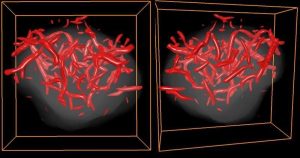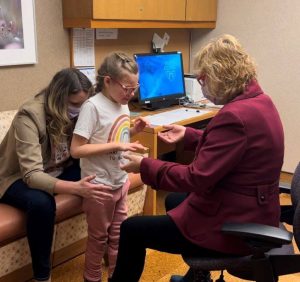[ad_1]

Mayo Clinic researchers make new discoveries, develop first-of-its-kind tools and technologies and constantly improve upon existing ones with the goal to provide the best in healthcare. The following 10 stories are a round-up of some of the most significant medical research advances at Mayo Clinic this year from harnessing artificial intelligence (AI) to detect disease sooner to advancing treatments for rare and complex diseases.
Advancing ultrasound microvessel imaging and AI to improve cancer detection

Tumors consist not only of cancer cells but also a matrix of small blood vessels, or microvessels, that cannot be seen in the images produced by conventional ultrasound machines. To solve this problem, physician-scientist Azra Alizad, M.D., and biomedical engineering scientist Mostafa Fatemi, Ph.D., teamed up at Mayo Clinic to design and study a tool that may improve the resolution of ultrasound imaging. As demonstrated in research findings, they developed high-resolution ultrasound imaging software, compatible with many ultrasound machines, that could exponentially improve both the detail and quality of images.
“If we can visualize and capture the microvessel in the earliest stages of cancer, we can better diagnose and treat it earlier, which improves the outcome for the patient,” says Dr. Alizad, who specializes in ultrasound technology for cancer imaging. Read more.
Harnessing the immune system to fight ovarian cancer

Mayo Clinic research is biomanufacturing an experimental, cell-based ovarian cancer vaccine and combining it with immunotherapy to study a “one-two punch” approach to halting disease progression in ovarian cancer patients. This research begins with a blood draw from women with advanced ovarian cancer whose tumors have returned after standard surgery and chemotherapy. White blood cells are extracted from the blood, biomanufactured to become dendritic cells and are returned to the patient. Dendritic cells act as crusaders that march through the body, triggering the immune system to recognize and fight cancer.
“We’re building on an earlier phase 1 clinical trial that showed promising results in terms of survival after the dendritic cell-based vaccine,” says Matthew Block, M.D., Ph.D., co-principal investigator and medical oncologist. “Of the 18 evaluable patients in the phase 1 study, 11 had cancer return, but seven of them — 40% — have been cancer-free for almost 10 years. We typically expect 90% of patients in this condition to have the cancer return.” Read more.
Mayo Clinic prepares to biomanufacture a new CAR-T cell therapy for B-cell blood cancers

Mayo Clinic research has developed a new type of chimeric antigen receptor-T cell therapy (CAR-T cell therapy) aimed at killing B-cell blood cancers that have returned and are no longer responding to treatment. This pioneering technology, designed and developed in the lab of Hong Qin, M.D., Ph.D., killed B-cell tumors grown in the laboratory and tumors implanted in mouse models. The preclinical findings are published in Cancer Immunology, Immunotherapy.
“This study shows our experimental CAR-T cell therapy targets several blood cancers, specifically chronic lymphocytic leukemia,” says Dr. Qin. “Currently there are six different CAR-T cell therapies approved for treatment of relapsed blood cancers. While the results are impressive, not everyone responds to this treatment. Our goal is to provide novel cell therapies shaped to each patient’s individual need.” Read more.
Artificial Intelligence is forging a new future for gastroenterology

Colonoscopy remains the gold standard in detecting and preventing colorectal cancer. But the procedure has limitations. Some studies suggest that more than half of post-colonoscopy colon cancer cases arise from lesions that were missed at patients’ previous colonoscopies.
“AI, particularly the subset of AI called computer vision, is naturally suited to what we do through the endoscope,” says Michael B. Wallace, M.D., who describes himself as a bit of a technology geek.
In 2022, Dr. Wallace published the results of an international, multicenter study testing the impact of adding AI to routine colonoscopies. His team, which included James East, M.D., a gastroenterologist at Mayo Clinic Healthcare in London, as well as researchers from the U.S., the U.K., Italy, Germany and Ireland, found that incorporating AI into colonoscopies reduced the risk of missing polyps by 50%. Read more.
Mayo Clinic discovery leads to life-changing treatment for young girl with ultra-rare disease

Just months after 9-year-old Mayo Clinic patient Maggie Carmichael started taking an experimental drug for her ultra-rare genetic disease that is part of a category of diseases known as congenital disorders of glycosylation, she was able to trade in her wheelchair for a walker. Maggie’s treating physician is Eva Morava-Kozicz, M.D., Ph.D., a translational scientist at Mayo Clinic who is at the forefront of research on congenital disorders of glycosylation.
In a recent discovery, Dr. Morava-Kozicz and her collaborators found that one of the major culprits of congenital disorders of glycosylation is a buildup of a substance called sorbitol, which is a type of sugar alcohol that is produced in the body when glucose is metabolized. Dr. Morava-Kozicz says the sorbitol discovery opened the door to a diagnostic biomarker for the disease and for tracking disease severity. She says the biomarker advancement provided a strategy for implementing potential drug candidates. Read more.
Can AI-enhanced heart screening address health disparities?

Clinicians and researchers around the world are combining artificial intelligence, known as AI, with health care to help identify patients at greater risk of cardiovascular diseases, such as stroke and heart failure. However, as use of these AI-enhanced tools grows, researchers at Mayo Clinic are asking, “Do these tools work reliably for people of color?” and “Are they accessible in community health care settings?”
“AI-based health interventions are frequently developed and deployed without race-specific data analysis or validation,” says David Harmon, M.D., Mayo Clinic cardiology fellow. “It’s important to make sure these tools are reliable and accessible to all, particularly people of color who are disproportionately affected by cardiovascular disease.” Read more.
Researchers link environmental exposures to liver disease

Mayo Clinic Comprehensive Cancer Center researchers uncover evidence supporting a shorter treatment time for breast cancer patients in a randomized trial, published in The Lancet Oncology. The study compared two separate dosing schedules of pencil-beam scanning proton therapy, the most advanced type of proton therapy known for its precision in targeting cancer cells while preserving healthy tissue to reduce the risk of side effects.
“The study provides the first prospective data supporting the use of shorter-course proton PMRT, including in patients with immediate breast reconstruction, and the first mature results of a randomized trial in the field of breast particle therapy,” says Robert Mutter, M.D., a radiation oncologist and physician-scientist at Mayo Clinic Comprehensive Cancer Center. “We can now consider the option of 15 days of therapy with patients based on the similar treatment outcomes observed as the longer conventional course. Of note, the short course actually resulted in reduced skin side effects during and after treatment.” Read more.
Mayo Clinic study reveals proton beam therapy may shorten breast cancer treatment

Mayo Clinic Comprehensive Cancer Center researchers uncover evidence supporting a shorter treatment time for breast cancer patients in a randomized trial, published in The Lancet Oncology. The study compared two separate dosing schedules of pencil-beam scanning proton therapy, the most advanced type of proton therapy known for its precision in targeting cancer cells while preserving healthy tissue to reduce the risk of side effects.
“The study provides the first prospective data supporting the use of shorter-course proton PMRT, including in patients with immediate breast reconstruction, and the first mature results of a randomized trial in the field of breast particle therapy,” says Robert Mutter, M.D., a radiation oncologist and physician-scientist at Mayo Clinic Comprehensive Cancer Center. “We can now consider the option of 15 days of therapy with patients based on the similar treatment outcomes observed as the longer conventional course. Of note, the short course actually resulted in reduced skin side effects during and after treatment.” Read more.
Scientists discover new brain area involved in movement

With a diagnostic procedure called electromyography, Mayo Clinic scientists and their international collaborators used electrodes to record the electrical response of muscles during each movement. The tests showed that an area deep in the central sulcus was active during all types of movement, challenging the long-held understanding that tissue in this part of the brain is tuned to specific regions of the body.
“We expected to find the known body organization map down to the depths of the brain, but we were surprised to also find this area that is active during all different movements,” says Kai Miller, M.D., Ph.D., a Mayo Clinic neurosurgeon and senior author of the study. “Emerging tactics for stimulating the brain to treat movement disorders like tremor may be able to leverage this for better therapeutic response.” Read more.
Menopause symptoms linked to adverse outcomes for women at work

Menopause-related symptoms such as hot flashes, night sweats, mood changes, sleep disturbances, joint aches and cognitive difficulties damage the quality of life for millions of women. They also can adversely affect women in the workplace. A Mayo Clinic study puts numbers on that cost: an estimated $1.8 billion in lost work time and $26.6 billion when medical expenses are added, in the U.S. alone. “The takeaway for employers is that there is a critical need to address this issue for women in the workplace,” says lead author Stephanie Faubion, M.D., director of Mayo Clinic Women’s Health. Read more.
This article first published on Discovery’s Edge.
Related articles
[ad_2]
Source link


